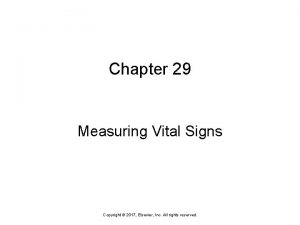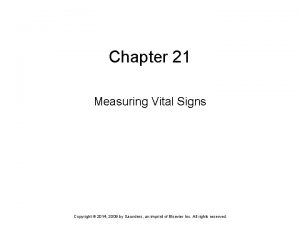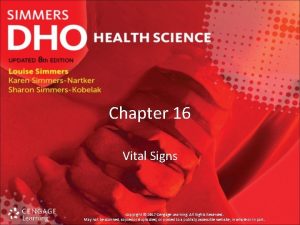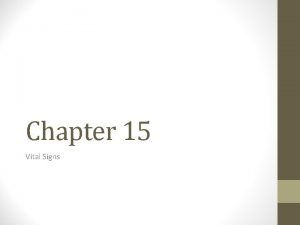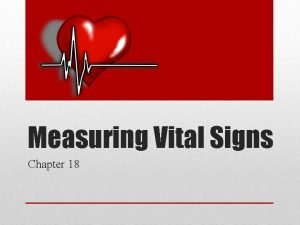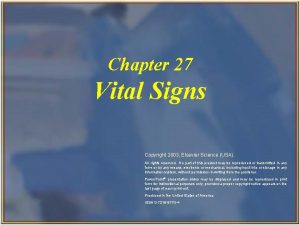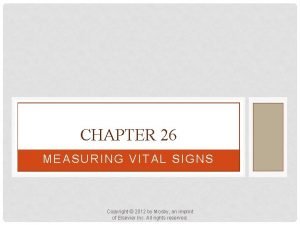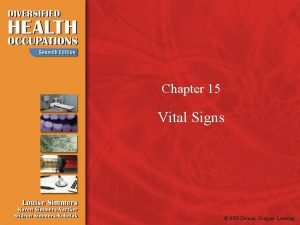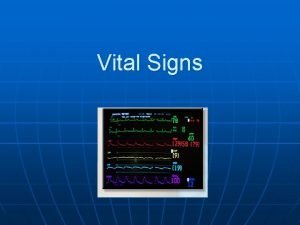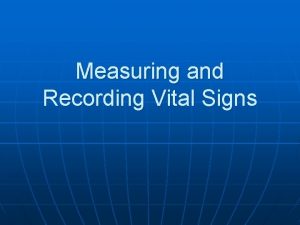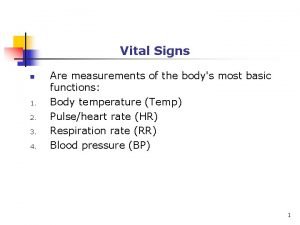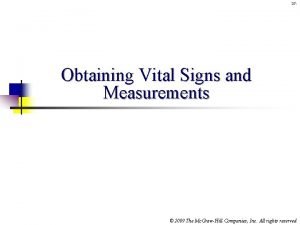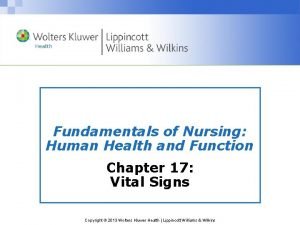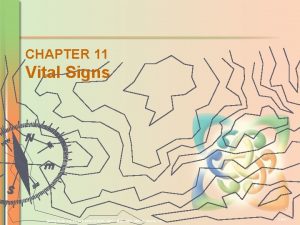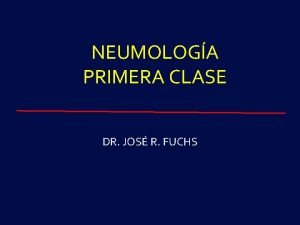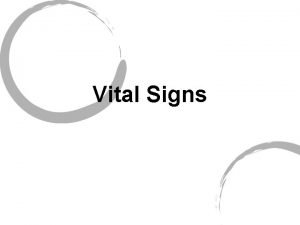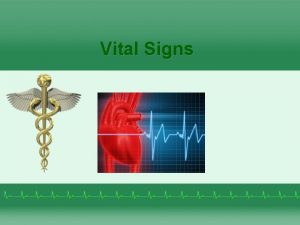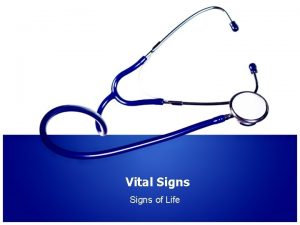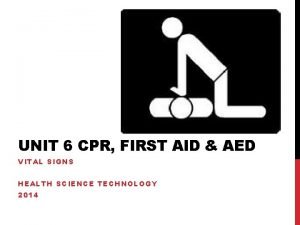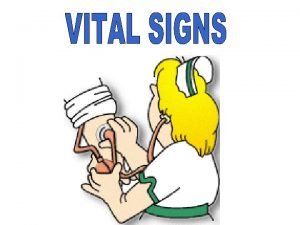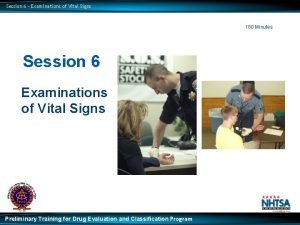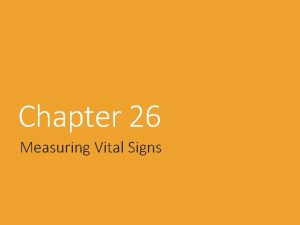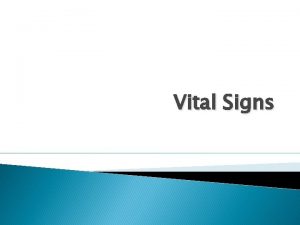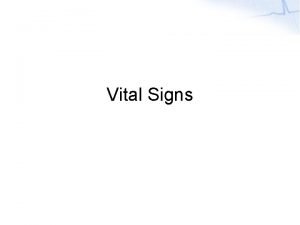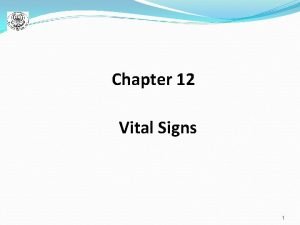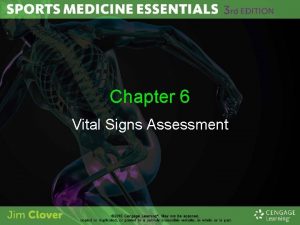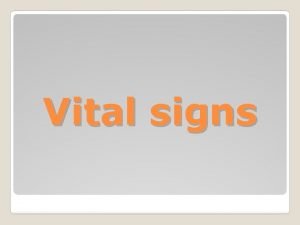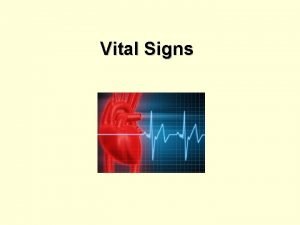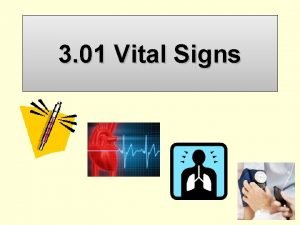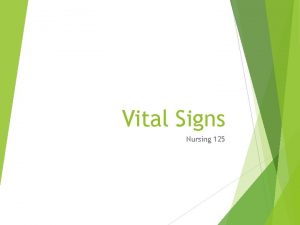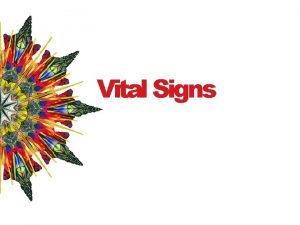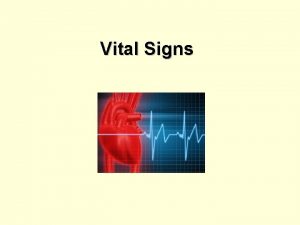Measuring Vital Signs Chapter 18 Introduction to Vital
































- Slides: 32

Measuring Vital Signs Chapter 18

Introduction to Vital Signs • Vital Signs are important indicators of your patient’s health status! They show whether or not the patient is in homeostasis (balance… wellness) • Vital Signs include: • • Body Temperature (T) Pulse (heart rate) (P) Respiration rate (R) Blood Pressure (B/P)

Other measures of well-being: • Presence/absence of Pain • Because pain is subjective, using a pain scale can help accuracy of reporting • Oxygen concentration • Measured through Pulse oximetry (measures oxygen concentration in the arterial blood) • Overall physical/mental status

Temperature • It is a measure of body heat • Heat is created and released by normal body functions • Heat is produced by (these make the body warmer) • Muscles • Glands • Oxidation of food • Heat is released by (these cool the body off) • Respiration • Perspiration • Excretion

Fever • A fever is not an illness… it is a sign of an illness! • Fevers are fighting FOR the person. . They are not necessarily a bad thing • Most pathogens thrive at 98. 6. A fever raises this temperature a couple of degrees making it harder for these germs to live. • A fever activates the body’s immune system so it makes more white blood cells and antibodies.

Cause of Elevated Body Temperature • Usually an infection with a pathogen (like a virus or bacteria) • Colds/Influenza/Bronchitis/Upper Respiratory Infections (URIs) like tonsillitis or laryngitis or sinus infections • Strep throat • Ear infection (otitis media) • Gastroenteritis (stomach “flu”) • Infectious mononucleosis (Epstein-bar virus) • Urinary tract infections (UTI… Bladder infection… Kidney infection) • Something more serious like appendicitis, meningitis, AIDS, CA (cancer), autoimmune disorders • OR SOMETIMES it’s a FUO (Fever of Unknown Origin)

Increase Decrease • • • Exercise Digestion of food Increased room temp. Illness Infection Excitement Anxiety Sleep Not eating (fasting) Cold room temp Decreased muscle activity Depression Factors Affecting Temperature

Vocab related to Temperature • Febrile: Pt. has a fever. Temperature more than 1 degree above the patient’s normal temperature. • Afebrile: Temperature within normal range. (a means without… so afebrile means without a fever… normal) • Hypothermia: Below the normal (usually less than 95 degrees)

Types of Thermometers • Glass tube with heat-sensitive liquid in it. • As the liquid heats up it moves up the tube • Read this thermometer by looking at the calibrated lines on the glass • Aural (ear) • Probe placed in ear. Reads temperature in about 1 sec. • Good for children (easy) but may have accuracy issues in children less than 6 years old • Electronic/Digital • Probe covered with a disposable shield. • Goes in mouth (oral) • Quick and easy to use.


Read the Glass thermometers

Newer Thermometers… • Temporal artery thermometer • No-touch infrared thermometer

Where to Take A Temperature • Oral (mouth) • Most common site • Normal range 97. 6 -99. 6 • Rectal • Most accurate • Average range 98. 6 -100. 6 (one degree higher than oral) • Aural (ear) • Same temperature range as Oral • Axillary (armpit) • Least accurate… so use only when other routes cannot be used • Normal Range 96. 6 -98. 6 (one degree lower than oral)

Pulse • Pulse is a measure of the heartbeat • It is caused by the pressure of the blood pushing against the wall of an artery as the heart contracts. • Indicates how well the blood is circulating through the body • Pulse is measured in beats per minute (BPM)

Radial Pulse: -Found in the side of the wrist under the thumb. -Place your fingers over an artery and squeeze gently against the bone.

How To Count Pulse Rate • Pulse is always measured in beats per minute (BPM) • So… you can… • Count for 1 full minute • Especially important if pulse is irregular • Count for 30 seconds and multiply by 2 • Example: If you counted 42 beats in 30 seconds, then 42 x 2 = 84 BPM • Count for 15 seconds and multiply by 4 • Example: If you counted 22 beats in 15 seconds, then 22 x 4= 88 BPM

Pulse • When checking the pulse, note the • Rate • Number of beats per minute (BPM) • Rhythm • Regular or irregular? • Irregular heart rhythms are called arrhythmias • Volume • Strength of each beat • Normal or Bounding (forceful) or Thready (weak)

Increase Pulse • >100 = Tachycardia • Tachy = fast • Cardi = heart • • • Exercise Illness (fever) Anxiety/excitement Some medications Shock (decreased blood volume/circulation from illness or severe bleeding) Decrease Pulse • <60 = Bradycardia • Brady = slow • Cardi = heart • High level of aerobic fitness (being in shape) • Depression • Some medications • Cardiac dysfunction • Sleep Factors Affecting Pulse

Normal Ranges Birth • 90 -160 BPM Birth – 1 year • 115 -130 BPM Children • 80 -115 BPM Adults • 60 -80 BPM

Apical Pulse • This is a pulse that is taken by placing a stethoscope at the apex (pointed end) of the heart and counting the beats per minute • The apex is located about 2 -3 inches below the left nipple. • This technique is used • • On infants When the radial pulse is difficult to assess When he radial pulse is irregular (weak, rapid etc. ) When the patient is taking medications that may alter the heart rate.

Respiration • Respiration is taking in oxygen (O 2) and expelling carbon dioxide (CO 2) • 1 inspiration + 1 expiration = 1 Respiration • Respiratory rate = # of breaths in one minute.


Counting Respiratory Rate • When you assess the respirations, don’t let the patient know what you are doing. If they do, they may not breathe normally. • Count the number of respirations after you count the pulse. • EXAMPLE: Hold the patient’s wrist while taking a radial pulse. Count for 30 seconds. Remember this number. • THEN, while continuing to hold the wrist, count the number of respirations in 30 seconds. • Multiply both numbers by 2 to get the rate per minute.

Factors that Affect Respiration Exercise Anxiety Respiratory disease Some medications Pain Heart disease Relaxation Depression Head Injury Some medications (narcotic pain medications)

Normal Respiration • For adults 12 -20 respirations per minute is normal • Dyspnea = Difficulty breathing • Dys = bad pnea=breathing • Apnea = Breathing stops • A = without pnea=breathing • When measuring respirations, note the following: • Rate • Number of respirations per minute • Rhythm • Regular or irregular • Quality • Amount of air exchanged and the effort it takes

Blood Pressure • Blood pressure is the force of the blood pushing against the walls of the blood vessels. • Systolic pressure: • Pressure in blood vessels when the heart contracts (beats), and the blood is forced out of the left ventricle and into the arteries. • Diastolic pressure: • Pressure in blood vessels when the heart relaxes (so it can refill with blood). • Normally, the systolic pressure is between 90 -140 and the diastolic pressure should be between 60 -90

Terminology • Hypotension : Low blood pressure • Hypertension: High blood pressure • Hypertension as a disease is also called “The Silent Killer” • Asymptomatic: Without symptoms • Sphygmomanometer (most people call it a blood pressure cuff) • Sphygmo refers to pulse • Mano refers to pressure • Meter refers to measure

How BP is Measured • The sphygmomanometer (BP cuff) has an inflatable cuff and a gauge which indicates the pressure • The cuff is placed on the arm and inflated. As it squeezes the arm, it stops the flow of blood. A stethoscope is placed over the brachial artery (inside of the elbow). As the pressure is reduced, the flow returns and you will hear the first heart beat. The pressure at the first beat you hear is the systolic pressure • As the cuff continues to deflate, eventually you will no longer hear any sounds. The pressure at the last beat you hear is the diastolic pressure. • These sounds you hear are called Korotkoff sounds

http: //www. youtube. com/ watch? v=Xhhn 08 Fy. Imw

Increase BP • Loss of elasticity in the arteries (arteriosclerosis… “hardening of the arteries”) • Exercise • Eating • Stimulants (caffeine) • Anxiety Decrease BP • Hemorrhage (lots of bleeding) • Inactivity • Fasting (not eating) • Suppressants (medications) • Depression Factors that Affect BP

Recording Vital Signs • VS are always written in this order: • T P R B/P • 98. 6 68 16 120/80 • Make sure you compare recent vital signs with previous ones. • Look for changes or patterns. • Look for any unusual readings (shallow respirations, weak thread pulse) • Note any vital signs that are outside of the normal range.

Video Clip on Vital Signs • http: //www. youtube. com/watch? v=f. F 321 Da. T 20&feature=related
 Chapter 14:7 measuring and recording blood pressure
Chapter 14:7 measuring and recording blood pressure Chapter 29 measuring vital signs
Chapter 29 measuring vital signs Copyright
Copyright 16.2 measuring and recording temperature
16.2 measuring and recording temperature Chapter 16:1 measuring and recording vital signs
Chapter 16:1 measuring and recording vital signs Chapter 26 measuring vital signs
Chapter 26 measuring vital signs Chapter 27 measuring vital signs
Chapter 27 measuring vital signs Apical radial pulse
Apical radial pulse Chapter 15:6 measuring and recording apical pulse
Chapter 15:6 measuring and recording apical pulse Seizure precautions nursing
Seizure precautions nursing Measuring and recording temperature
Measuring and recording temperature Regularity of the pulse or respirations
Regularity of the pulse or respirations All traffic signs and meanings
All traffic signs and meanings Definition of vital signs in nursing
Definition of vital signs in nursing Chapter 37 vital signs and measurements true or false
Chapter 37 vital signs and measurements true or false Vital sign normal
Vital sign normal Fundamentals of nursing chapter 17 vital signs
Fundamentals of nursing chapter 17 vital signs Test chapter 16 vital signs
Test chapter 16 vital signs Chapter 11 vital signs
Chapter 11 vital signs Volúmenes pulmonares
Volúmenes pulmonares Vital sign
Vital sign Vital signs normal rate
Vital signs normal rate Respiration as a vital sign
Respiration as a vital sign Vitals by age
Vitals by age Normal level of vital signs
Normal level of vital signs Summary of vital signs
Summary of vital signs 8 vital signs
8 vital signs 5 tanda vital sign
5 tanda vital sign Normal range for vital signs
Normal range for vital signs Conclusion on vital signs
Conclusion on vital signs 6 vital signs first aid
6 vital signs first aid Artery parts of the body to locate pulse beat
Artery parts of the body to locate pulse beat 6 vital signs
6 vital signs

